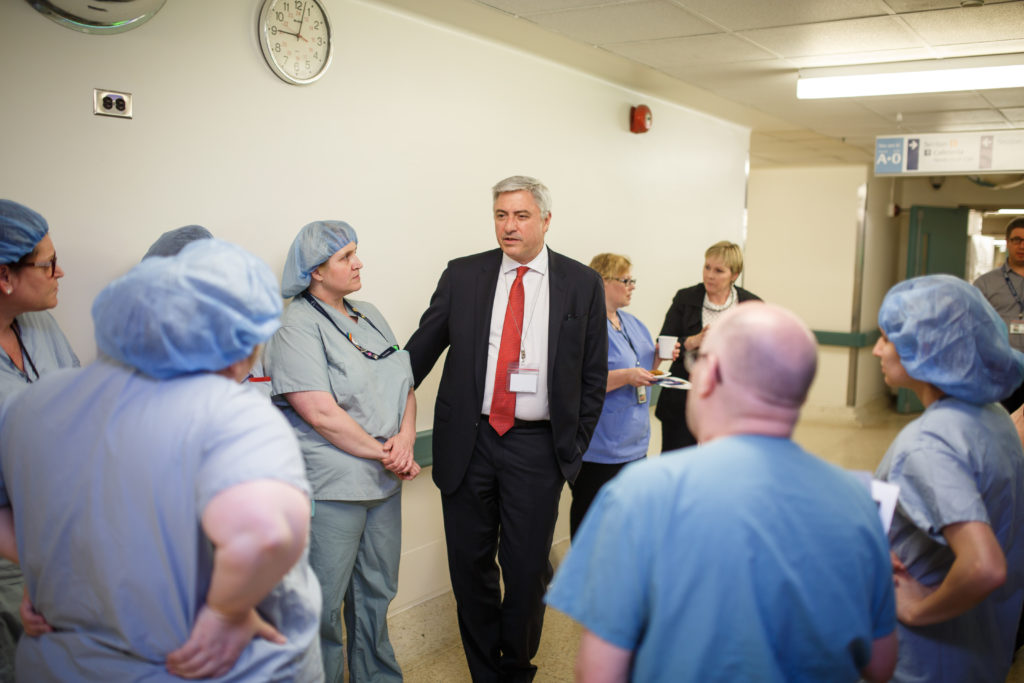
BLOG: Breaking the cycle of crowded hospitals
By: Rob MacIsaac, president & CEO, Hamilton Health Sciences
The Ontario government recently re-introduced the province’s health system restructuring legislation, the Patients First Act, now known as Bill 41. The Bill, once enacted, will be an important enabler for us in Hamilton to change the way our health care is coordinated and delivered. In so doing, we have a chance to deliver better care for people in our community while also creating a more sustainable health care system.
“Everyone knows where the hospital is, we never close, and we don’t turn anyone away. As a result, we have become the provider of a very broad range of health care and social services.”
Why is change needed? For starters, we are using our hospitals too much and for too many things. That’s not surprising. Everyone knows where the hospital is, we never close, and we don’t turn anyone away. As a result, we have become the provider of a very broad range of health care and social services.
If you have multiple, chronic health conditions, if you are living in poverty, or if you often need health services after hours, there is a good chance you’ll turn to a hospital for service on a regular basis. Some people visit the Emergency Departments at Hamilton Health Sciences multiple times each week. This might seem like an abuse of the service, but these people really do need help – they are often in genuine crisis.
To the credit of our frontline workers, hospitals respond with compassion. We assess people on the spot, provide them medical attention, admit them to a bed when necessary, help them through their crisis, and send them home. But then they come back and the cycle repeats itself.
“[Population health] addresses the reality that our community’s health is profoundly affected by factors far removed from the medical care offered by a hospital.”
What if we could instead help break the cycle by working collaboratively with social services and other health service providers in the community? What if we began proactively intervening to help people better manage their health to reduce the chance they will need hospital care? This concept is called population health. It addresses the reality that our community’s health is profoundly affected by factors far removed from the medical care offered by a hospital.
Housing, income, education, and family support are all significant determinants of how much you will use a hospital. If you don’t have a roof over your head, if you aren’t eating properly, if you don’t have a family member around to catch you when you fall, you are very likely to become a frequent user of hospital services.
At Hamilton Health Sciences, we are using a population health approach to plan the development of our hospital services and the long term redevelopment of our facilities (OurHealthyFuture.ca). This is not a quick or easy fix. But we believe that, over the long-term, a population health approach will make our community healthier and help us better manage the growing demand for hospital services.
There’s no universal definition of population health. At Hamilton Health Sciences, it means that we want to get ahead of the demand for hospital services by addressing the numerous factors that put people at risk for hospitalization. This will require taking a coordinated approach to providing the broadest range of health services to our community – from disease treatment to prevention, rehabilitation to management, and also health promotion and protection.
“We’ll know we have succeeded in this effort when our hospitals are no longer filled beyond their capacity.”
Two important examples of health conditions that can be better managed using a population health approach are Chronic Heart Failure (CHF) and Chronic Obstructive Pulmonary Disorder (COPD). Together, they are the leading causes of potentially preventable hospitalization in our community. These are progressive health conditions that, when left untreated or mismanaged, can require numerous and lengthy visits to the hospital. The better response, though, may be teaching someone how to properly use and better manage their medication, or ensuring they have appropriate housing, or simply providing them with access to a friendly voice who understands their challenges and provides good advice.
This kind of approach is pretty far from today’s reality. If we are to change this channel, we’ll need to change the way family medicine, home care, first responders, social services and hospitals work with each other. At HHS, we are now actively collaborating with the City of Hamilton to boost supportive housing in our community because we know that a lack of housing creates an over-reliance on our services. Similarly, we want to work with family doctors, home care and social service providers, as well as public health to find new ways to serve the community together.
Sustaining these efforts will mean acknowledging our shared responsibility for providing the best possible care to our community. It will also require openness from all sides to finding new ways of working together. We’ll know we have succeeded in this effort when our hospitals are no longer filled beyond their capacity.
Rob MacIsaac is President and CEO of Hamilton Health Sciences
